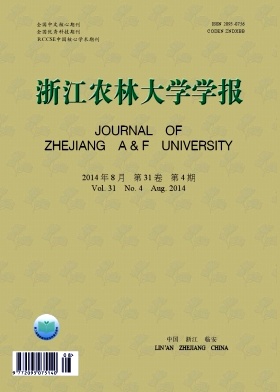-
竹炭(bamboo charcoal)是竹材在无氧或缺氧条件下高温热解得到的产品,在生产竹炭的过程中还能得到副产品竹醋液(bamboo pyroligneous liquor),是目前竹材加工领域中利用率最高、附加值最大的科技产品之一。竹炭拥有大孔、中孔和微孔各种孔隙结构,比表面积可达382 m2·g-1,因此有较强的吸附性能,可广泛应用于空气净化[1-4]、水质净化[5-15]和土壤改良[16-17]等领域;竹炭显微构造类似并接近于洋葱状富勒烯碳和展开的碳纳米管的特殊结构,因此,具有能产生远红外线,释放负离子的特性,可开发保健日用产品[18-22];同时,竹炭还具有良好导电性,可开发抗静电、电磁屏蔽、超级电容器电极等功能型新材料。笔者就竹炭导电机制、竹炭导电性影响因素、竹炭及其复合材料的电磁屏蔽性能、竹炭超级电容器电极材料等方面研究进展进行了综述,旨在提出该领域今后的研究发展方向。
HTML
-
竹炭导电机制的研究,目前主要分为炭化温度低于1 000 ℃和高于1 000 ℃ 2种情况。低于1 000 ℃竹炭的导电主要有由离子引起或π电子移动引起2种观点;高于1 000 ℃,一般认为与竹炭石墨化程度的提高有关。
Cheng等[23]发现3 000 ℃竹炭陶瓷的X射线衍射分析(XRD)图谱并没有明显的石墨峰,推测竹炭为难石墨化炭材料。张文标等[24]研究发现在炭化温度900 ℃以下,未出现石墨化结构特征峰,难以形成石墨化结晶,同木炭结论相似[25],其导电主要是离子引起的,而在800 ℃时出现了碳碳双键与苯环共轭的强吸收峰,导电性增强,在温度1 100 ℃以上竹炭有形成石墨化结构趋势。赵丽华等[26]研究了炭化温度从550~1 000 ℃制备的竹炭导电性关系,认为竹炭的导电性与竹炭中π电子数有关,炭化温度的升高引起π电子数不断增加,导致竹炭导电性增强。江泽慧等[27]研究500 ℃,750 ℃和1 000 ℃时竹炭的导电性结果表明:导电性的增强原因与竹炭的形貌、结构和化学组分等有关。随着炭化温度的升高,在形貌方面,竹炭维管束外鞘变得光滑、致密、平整,同时维管束和薄壁组织的收缩程度增大,细胞间隙变小;在结构方面,无序碳及单个网平面层的比例减少,微晶进一步成长,微晶的取向趋于整齐一致;在化学组分方面,由与构成竹材聚合物分子中的离子基缔合在一起而产生的离子以及竹材无机成分中所含杂质产生的离子组成的竹炭离子的移动产生了极化,这都使得竹炭导电性增强了。
-
竹炭电阻率是衡量竹炭导电性能的一项重要指标。通过测量竹炭电阻率,在一定程度上可表征其导电性能,竹炭电阻率越小,导电性越好,反之亦然。竹炭电阻率的研究,主要集中在竹林立地条件、竹材部位、炭化工艺(炭化温度、炭化速率和保温时间)、竹炭粒径大小、微观结构及竹炭的基本理化性能指标等。
林新春等[28]采用5年生的集约经营型的毛竹Phyllostachys edulis,在相同炭化工艺条件下制备竹炭,测得不同产地的竹炭电阻率各不相同,其电阻率大小依次为宁波、景宁、江山、安吉。江泽慧等[27]使用数字式四探针测试仪研究了块状竹炭的导电性能,结果表明:750 ℃以上处理的竹炭内表面及内表面和外表面之间部分的电阻率差异很小,但竹炭外表面的电阻率低于其他部位,即导电性明显高于其他部位。张文标[29]研究认为炭化温度对竹炭的导电性影响显著,随着炭化温度升高,其电阻率减少,且在炭化温度600~800 ℃时电阻率显著降低;不同的炭化工艺条件下,其电阻率各不相同;在同一工艺条件下,竹材不同部位制备的竹炭的电阻率不同,呈现从基部到梢部降低趋势。电阻率大小还与竹炭的结构、灰分含量有关,竹炭微晶的取向趋于整齐一致时,导电性增加;灰分中的一些可溶性的钾和钠的硫酸盐,不溶性的硅酸盐以及少量磷酸盐等物质的含量增加,促使离子的移动产生极化,导致竹炭导电性增强。
Nomura[30]对竹炭的电阻特性进行了初步研究,得出电阻率与竹炭的烧制温度有关,并对竹炭的电阻率测定方法进行了研究。Yokochi等[31]研究发现竹炭电阻率随着炭化温度的上升,电阻率开始下降,在700~800 ℃范围内急剧下降,在1 000 ℃之后变化缓慢;岩田圭司[32]研究发现炭化炉中不同部位炭化时的升温速率不同,影响了相应位置竹材的热解程度,导致同一炭化炉中的竹炭电阻率相差较大。邵千钧等[33]采用竹炭二次炭化的方法来研究电阻率的影响因素。研究表明:对于同一炭化温度,随炭化时间延长,电阻率从开始的下降显著到后面下降趋于缓慢。Hwang[34]采用台湾的毛竹(当地称孟宗竹)在传统的砖土窑中烧制竹炭,发现炭化温度在窑中分布很不均匀,测得竹炭电阻率呈现从窑顶部到底部增大趋势,与窑体高度直接有关。
赵丽华等[26]研究认为:竹炭电阻率与微观结构、密度和灰分有关,竹炭维管束收缩越紧密,密度越大,细胞之间结合更紧密,形成规则晶格结构,因此,电阻率减小。灰分在竹炭中的金属元素的含量及离子络合物形式的存在减少了竹炭电阻率。傅秋华等[35]研究认为,竹炭灰分中的一些元素,如磷、硅、钙等杂质掺和在竹炭中,使竹炭成为杂质半导体的性质,使其电阻率变小,从而导致了导电性的增强;同时得出竹炭电阻率随固定碳含量和pH值的增加而不同程度的降低,而随着竹炭挥发分含量的降低而降低的结论。郑志锋等[36]对竹炭的微粉制备与性能结构进行了研究,得出竹炭颗粒粒径越小,电阻率越小,它与石墨、碳纤维等其他碳系导电变化规律相似的结论。
-
从20世纪末90年代初开始,国内外学者相继开展竹炭及其复合材料的电磁屏蔽效能方面的研究工作。体积电阻率在100.00~10 000.00 Ω·cm范围的称为导电材料可作为静电屏蔽材料使用,由于竹炭的导电性好、密度较低、化学稳定性好,可利用它发展轻质静电屏蔽材料。据报道,在频率为10.0~1 000.0 MHz的范围内,3 mm厚的竹炭复合材料的电磁屏蔽效能为45~75 dB[37]。新村孝善等[38]研究发现,750 ℃以上炭化得到的竹炭,电阻率为0.10 Ω·cm,其对频率4.0 GHz的电磁波衰减30 dB,对35.0 GHz的电磁波衰减60 dB以上,表现出良好电磁波屏蔽效能。石原茂久等[39-40]发现在频率为10.0~3 000.0 MHz的范围内竹炭的电磁屏蔽效能约为23 dB。Lin等[41]研究发现竹炭聚酯纤维织物对500.0 MHz的电磁波的屏蔽效能为45 dB。黄彪等[42]在一篇综述中提到:日本许多研究者认为,竹炭可制作高导电材料,具有电磁波屏蔽性能、质量轻、可耐火耐热、化学稳定性好等特点,可用在电子仪器、船车、涂料及新型高级建筑材料上,以竹炭为原料研制出导电竹炭新材料及导电高分子防电磁波材料。该材料与热固性树脂混熔加工成各种形状的板材等复合材料,这些材料均具有优异的电磁波屏蔽效果,可减少电磁波对人体影响及对电子仪器误动作的危害。
邓丛静等[43]研究了竹炭/硅橡胶高导电复合材料的电学性能,发现当甲基乙烯基硅橡胶(MVQ),竹炭(粒径小于25 μm,体积电阻率为0.11 Ω·cm),气相法白炭黑,过氧化二异丙苯(DCP)、羟基硅油质量比为100:130:3:3:2时,制备的复合材料的电阻率为0.63 Ω·cm,达到了竹炭/硅橡胶高导电复合材料的体积电阻率要求。叶良明等[44]发明一种电磁屏蔽的炭基板及其制作方法,主要以导电竹炭为基本材料,按质量百分比与合成树脂胶均匀混合,加工成各种形状板,具有较好的电磁屏蔽效能。闫国褀[45]研究表明,在频率为0~3.0 GHz的范围内,炭化温度为700 ℃的竹炭的电磁屏蔽效能为3~6 dB,负载硝酸铜的竹炭随铜元素含量的提高,电磁屏蔽效能明显升高,当铜元素为152.0 mg·g-1时,竹炭的电磁屏蔽效能可达到24 dB。Wu等[46]通过竹炭与聚苯胺复合得到了电磁屏蔽材料,研究发现竹炭聚苯胺复合材料在频率为2.0~40.0 MHz的范围内具有优良的电磁屏蔽特性,对7.2 GHz和33.0 GHz的电磁波的屏蔽效能分别为8 dB和17 dB。Wu等[47]用不同的竹炭/苯胺的比(竹炭/苯胺=1/1,1/2,1/3)经原位聚合,合成了涂有聚苯胺的竹炭原料,并引入到环氧树脂形成微波吸收体,再对其微波吸收性能进行了研究,测量了复合物介电常数,复合物通透性,并采用自由空间法测量了复合物在2.0~18.0 GHz和18.0~40.0 GHz的微波频率范围内的反射损耗。研究结果表明:通过在竹炭中添加不同的聚苯胺,可以获得更加宽泛的吸收频率范围。
-
竹炭可作为双电层电容器的电极材料,目前的研究主要集中于竹炭基活性炭的电化学性能,竹炭改性超级电容器电极的制备等方面。
刘洪波等[48]将竹炭制成了竹炭基高比表面积活性炭,作为双电层电容器电极,得出其充放电特性及其比电容与各种因素的关系。通过一定工艺,制得的高比表面积活性炭的双电极比电容达55.000 F·g-1。白翔等[49]用氢氧化钾在碱炭比4:1,保温1 h的条件下活化获得的活性炭在0.050 mA·g-1下充放电比容量达到了207.000 F·g-1。宁娈等[50]利用竹炭复合二氧化锰,以机械球磨法制得超级电容器,电极比容量可以达到338.000 F·g-1,100次循环后可以维持在260.000 F·g-1。张勇等[51]研究发现:炭化温度为500 ℃时,制备出来的竹炭具有最好的电化学性能,这主要归因于其特殊的孔结构和高的比表面积,其在125 mA·g-1电流密度下的首次放电比电容为226.000 F·g-1,在500.000 mA·g-1的大电流密度下,其放电比电容仍高达184.000 F·g-1,循环1 000次其放电比电容还为138.000 F·g-1,每次循环电容衰减仅为0.046 F·g-1。王力臻等[52]研究以微波功率640 W,辐射时间12 min的工艺条件制备竹炭,结果表明:该竹炭在100.000 mA·g-1的电流充放电下,首次放电比电容为242.300 F·g-1,第1 000次循环的比电容为229.120 F·g-1,电容保持率为94.56 %,并得出竹炭适合大电流充放电的结论。张文标等[53]采用竹粉和混合碱的比1:3且两者活化剂比例相等时,活化温度900 ℃,活化时间1 h条件下制备的竹活性炭性能最佳,其比表面积为1 003.200 m2·g-1, 总孔容为0.564 cm3·g-1,作为超级电容器(EDLC)的电极,其比电容为101.100 F·g-1。
竹炭还可制备电容电极材料,应用于废水去重金属离子甚至医学方面等。张玲等[54]发现电压、电极片间的距离、溶液的pH值是影响电容去离子效果的主要因素,得出各因素的影响次序为:外加电压、溶液的pH值、电极片的距离,其中最佳的电容去离子条件为:电压为1.55 V,电极片间距离为2.0 cm,pH 5.16。张玲等[55]发现原材料(活性炭、导电剂、黏结剂)的配比、电极厚度及载炭量对电极性能的影响极大,在最佳的电容去离子条件下,去除废水中铜离子(Cu2+),铅离子(Pb2+)重金属离子可达75%。顾玲等[56]研究出竹炭与石墨、甲基硅油混合制备竹炭修饰电极,发现对多巴胺的电化学氧化还原过程产生促进作用,可用于多巴胺注射液中多巴胺含量的测定。
Lee等[57]制备出了用于超级电容器的活性竹炭,实验发现:竹质活性炭具有较好的微孔结构,中孔所占比例很大,能够作为离子的快速通道,从而提高电解液的渗透率,还发现活性竹炭的比电容要比椰子壳活性炭的比电容高很多。
-
随着科技的进步,各种电子电气设备走进人们的日常生活。同时,电子电气设备的使用会出现电磁辐射与干扰等问题,危及人们的健康。如何利用竹炭良好导电性、轻质、价廉、化学稳定等特点,开发出理想的竹炭基电磁屏蔽材料和电容器电极是竹炭研究与应用的一个重要领域,结合目前导电竹炭生产技术及应用存在的不足,为此提出今后在以下4个方面加以重点深入研究。
-
目前,竹炭生产设备主要依靠传统的砖土窑设备,生产效率低、窑体温差大、工艺难控制、产品质量参差不齐。为了克服上述缺陷,国内已研发出一些竹炭机械生产设备,并在生产中得到一定的推广应用,但从应用效果看还存在不足,比如能源消耗大、原材料规格有限制、装卸劳动强度大、产量不高、竹焦油堵塞管道等问题。为了得到导电性能高质量稳定的竹炭产品,必须采取一方面引进消化吸收国外先进设备技术对现有设备进行改良;另一方面要加大研发力度,开发能源自给型竹炭清洁生产设备,以解决目前国内竹炭生产难以规模化及质量性能不稳定等问题。
-
竹炭的导电机制,在炭化温度低于1 000 ℃时,是由离子引起的,或是由π电子移动引起的,还是两者协同作用引起的,尚未形成明确的结论;目前炭化温度最高可达到1 100 ℃,论断1 000 ℃以上竹炭导电与石墨化有关,缺少科学性,对于更高炭化温度条件下制备的竹炭,其石墨晶体是否存在及石墨化程度的高低等问题有待进一步探究。因此还需深入开展竹炭导电机制的研究,从理论上阐释产生导电原因,以获得不同电阻值的竹炭,为今后导电竹炭及产品开发奠定理论基础。
-
竹炭导电性影响因素的研究,目前较多在炭化温度方面,对竹林产地、竹材部位、竹炭本身颗粒大小等因素的研究尚有不足,缺乏系统性,特别是综合考虑这些因素对导电性影响的研究。其实竹炭导电性与炭化工艺(炭化温度、炭化速度、反应时间和窑体内压力),原材料(竹龄、竹材部位、立地条件、不同的竹种),竹炭结构(孔径、孔容、比表面积),竹炭理化性质(灰分、密度、固定碳),竹炭储存环境(吸附水、空气中物质、气体)等因素有关。为此,应运用试验设计方案进行优化设计,选择合理的因素和水平进行正交试验,获得导电竹炭的各影响因子和最优的导电竹炭的生产工艺和条件,从而有利于开发导电竹炭的深加工产品,提高竹炭产品附加值。
-
要在竹材原材料改性、炭化工艺优化、竹炭改良等方面进行深入研究,开发出高导电的竹炭原材料,继而开发出特殊用途的高屏蔽竹炭复合材料。同时要利用竹炭的大孔、中空和微孔的孔隙结构及独特的洋葱状富勒烯碳和展开的碳纳米管的特殊结构,开发特殊锂离子负极材料、超级电容器以及竹炭燃料电池等高科技领域产品。






 DownLoad:
DownLoad: